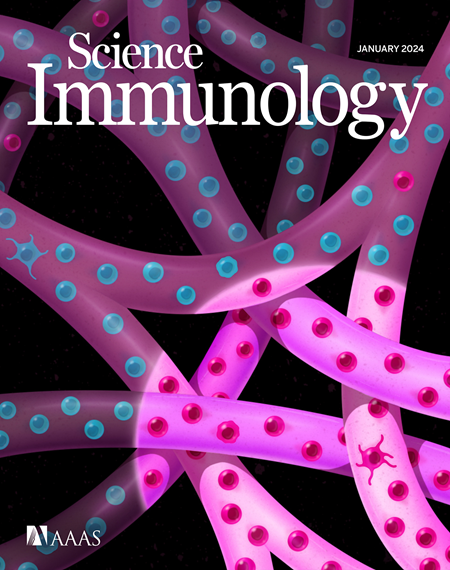Circulating KLRG1+ long-lived effector memory T cells retain the flexibility to become tissue resident
IF 17.6
1区 医学
Q1 IMMUNOLOGY
引用次数: 0
Abstract
KLRG1+ CD8 T cells persist for months after clearance of acute infections and maintain high levels of effector molecules, contributing protective immunity against systemic pathogens. Upon secondary infection, these long-lived effector cells (LLECs) are incapable of forming other circulating KLRG1− memory subsets such as central and effector memory T cells. Thus, KLRG1+ memory T cells are frequently referred to as a terminally differentiated population that is relatively short lived. Here, we show that after viral infection of mice, effector cells derived from LLECs rapidly enter nonlymphoid tissues and reduce pathogen burden but are largely dependent on receiving antigen cues from vascular endothelial cells. Single-cell RNA sequencing reveals that secondary memory cells in nonlymphoid tissues arising from either KLRG1+ or KLRG1− memory precursors develop a similar resident memory transcriptional signature. Thus, although LLECs cannot differentiate into other circulating memory populations, they still retain the flexibility to enter tissues and establish residency.
循环中的 KLRG1 + 长效效应记忆 T 细胞具有成为组织常驻细胞的灵活性
KLRG1 + CD8 T 细胞在急性感染清除后可存活数月,并保持高水平的效应分子,对全身性病原体产生保护性免疫力。二次感染后,这些长效效应细胞(LLECs)无法形成其他循环的 KLRG1 - 记忆亚群,如中枢记忆 T 细胞和效应记忆 T 细胞。因此,KLRG1 + 记忆 T 细胞经常被称为寿命相对较短的终末分化群体。在这里,我们发现在小鼠受到病毒感染后,来自 LLECs 的效应细胞会迅速进入非淋巴组织并减轻病原体的负担,但在很大程度上依赖于从血管内皮细胞接收抗原线索。单细胞 RNA 测序显示,非淋巴组织中由 KLRG1 + 或 KLRG1 - 记忆前体产生的次级记忆细胞具有类似的常驻记忆转录特征。因此,虽然 LLECs 无法分化成其他循环记忆群体,但它们仍能灵活地进入组织并建立驻留。
本文章由计算机程序翻译,如有差异,请以英文原文为准。
求助全文
约1分钟内获得全文
求助全文
来源期刊

Science Immunology
Immunology and Microbiology-Immunology
CiteScore
32.90
自引率
2.00%
发文量
183
期刊介绍:
Science Immunology is a peer-reviewed journal that publishes original research articles in the field of immunology. The journal encourages the submission of research findings from all areas of immunology, including studies on innate and adaptive immunity, immune cell development and differentiation, immunogenomics, systems immunology, structural immunology, antigen presentation, immunometabolism, and mucosal immunology. Additionally, the journal covers research on immune contributions to health and disease, such as host defense, inflammation, cancer immunology, autoimmunity, allergy, transplantation, and immunodeficiency. Science Immunology maintains the same high-quality standard as other journals in the Science family and aims to facilitate understanding of the immune system by showcasing innovative advances in immunology research from all organisms and model systems, including humans.
 求助内容:
求助内容: 应助结果提醒方式:
应助结果提醒方式:


